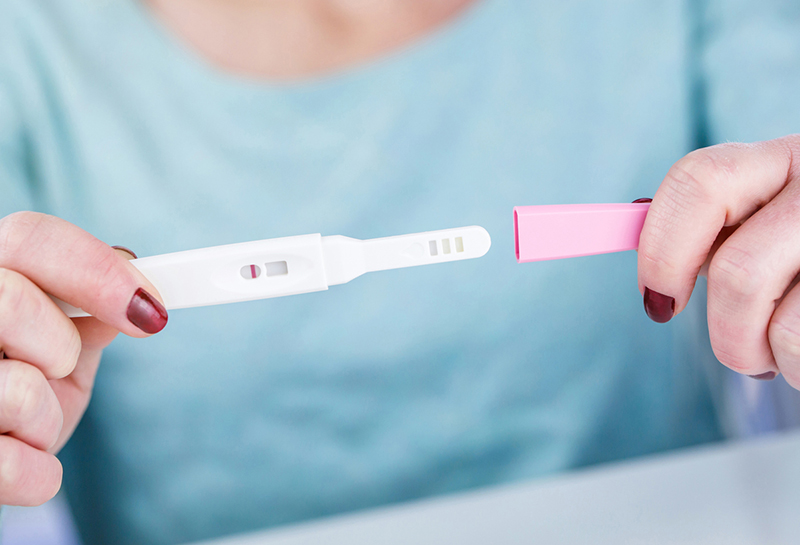
Preemptive treatment for a nonviable pregnancy of unknown location—a situation in which there is a positive pregnancy test result but the location of the pregnancy cannot be confirmed within or outside the uterus with other diagnostic tests—resolves the condition more rapidly than treating symptoms as they arise, suggests a study supported by the National Institutes of Health. However, both treatment approaches convey similar risks of adverse events, principally vaginal bleeding or, when the pregnancy is later determined to be an ectopic pregnancy (pregnancy outside of the uterus), rupture of a fallopian tube.
When a pregnancy is not progressing as expected and cannot be visualized with ultrasound and other physical examinations, pregnancy of unknown location is confirmed by detection of human chorionic gonadotropin (hCG), a hormone secreted by cells that later become the placenta. Treatment is typically offered when hCG levels remain consistently low, an indication that the fetus did not develop and only remnant cells remain.
If the pregnancy is later determined to be an ectopic pregnancy, if it is untreated, it may lead to severe bleeding and death of the mother. Similarly, a nonviable pregnancy elsewhere may lead to bleeding or scarring of the uterus, which could complicate future pregnancies.
The study was conducted by Kurt T. Barnhart, M.D., of the University of Pennsylvania and colleagues. It appears in the Journal of the American Medical Association. Funding was provided by NIH’s Eunice Kennedy Shriver National Institute of Child Health and Human Development (NICHD).
“The findings suggest that treatment can be tailored to the wishes and needs of each individual patient,” said study author Esther Eisenberg, M.D., M.P.H., of the NICHD Fertility and Infertility Branch. The study authors added that participants in all the study groups rated the treatment they received as satisfactory and acceptable.
Little research has been conducted on the most effective treatment for pregnancy of unknown location. Treatment options include the drug methotrexate, evacuation (scraping) of the uterine lining, or expectant management—close observation of the patient and foregoing treatment unless symptoms occur.
The current study involved 253 patients. Researchers found that those given methotrexate, with or without uterine evacuation, recovered more quickly, without the need for additional treatment, compared to those in the expectant management group. Of the total, five patients had surgery for ectopic pregnancy: two in the expectant management group, two who underwent uterine evacuation, and one treated with methotrexate.
Patients were randomized to receive either expectant management, uterine evacuation followed by methotrexate, if needed, or two doses of methotrexate alone. Traditionally, uterine evacuation is performed to identify the location of the nonviable pregnancy. If placental cells are not found in the uterus, then the pregnancy is ectopic, and methotrexate may be given.
Patients could decline randomization and choose to be part of another treatment group. Roughly 27% declined expectant management, 48% declined uterine evacuation, and 42% declined the two-dose regimen. Compared to patients randomized to expectant management, patients assigned to the other groups were more likely to achieve pregnancy resolution without the need for additional treatment. Those randomized to receive two doses of methotrexate were slightly more likely to achieve pregnancy resolution without additional treatment than those in the uterine evacuation group (nearly 55% vs. roughly 48%). Vaginal bleeding was the most common adverse event in all three groups, ranging from roughly 44% to almost 53%.
A patient randomized to expectant management was later found to have a growing pregnancy in the uterus, a rare occurrence after initially low hCG levels. After six days, subsequent hCG levels rose normally. The woman had conceived after infertility treatment and delivered at term without any complications. The authors wrote that this participant’s experience underscores the need to ensure a pregnancy of unknown location is nonviable before proceeding with treatment.
Reference
Barnhart KT, et al. Effect of an active vs expectant management strategy on successful resolution of pregnancy among patients with a persisting pregnancy of unknown location: The ACT or NOT randomized clinical trial. Journal of American Medical Association. 2021.
###
About the Eunice Kennedy Shriver National Institute of Child Health and Human Development (NICHD): NICHD leads research and training to understand human development, improve reproductive health, enhance the lives of children and adolescents, and optimize abilities for all. For more information, visit https://www.nichd.nih.gov.
About the National Institutes of Health (NIH): NIH, the nation’s medical research agency, includes 27 Institutes and Centers and is a component of the U.S. Department of Health and Human Services. NIH is the primary federal agency conducting and supporting basic, clinical, and translational medical research, and is investigating the causes, treatments, and cures for both common and rare diseases. For more information about NIH and its programs, visit https://www.nih.gov.

 BACK TO TOP
BACK TO TOP